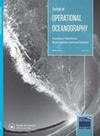Surface currents in operational oceanography: Key applications, mechanisms, and methods
IF 2.4
3区 地球科学
Q4 METEOROLOGY & ATMOSPHERIC SCIENCES
引用次数: 16
Abstract
ABSTRACT This paper reviews physical mechanisms, observation techniques and modelling approaches dealing with surface currents on short time scales (hours to days) relevant for operational oceanography. Key motivations for this article include fundamental difficulties in reliable measurements and the persistent lack of a widely held consensus on the definition of surface currents. These problems are augmented by the fact that various methods to observe and model ocean currents yield very different representations of a surface current. We distinguish between four applicable definitions for surface currents; (i) the interfacial surface current, (ii) the direct wind-driven surface current, (iii) the surface boundary layer current, and (iv) an effective drift current. Finally, we discuss challenges in synthesising various data sources of surface currents - i.e. observational and modelling – and take a view on the predictability of surface currents concluding with arguments that parts of the surface circulation exhibit predictability useful in an operational context.海面洋流在业务海洋学:关键应用、机制和方法
本文综述了与业务海洋学相关的短时间尺度(小时到天)表面流的物理机制、观测技术和建模方法。本文的主要动机包括可靠测量的基本困难,以及对表面流的定义一直缺乏广泛持有的共识。观察和模拟洋流的各种方法所产生的表面洋流的表现形式非常不同,这一事实使这些问题更加严重。我们区分了四种适用于表面电流的定义;(i)界面表面电流,(ii)直接风驱动的表面电流,(iii)表面边界层电流,以及(iv)有效漂移电流。最后,我们讨论了在综合各种表面流数据源方面的挑战——即观测和建模——并对表面流的可预测性提出了看法,结论是部分表面环流在操作环境中表现出有用的可预测性。
本文章由计算机程序翻译,如有差异,请以英文原文为准。
求助全文
约1分钟内获得全文
求助全文
来源期刊
CiteScore
7.50
自引率
9.70%
发文量
8
审稿时长
>12 weeks
期刊介绍:
The Journal of Operational Oceanography will publish papers which examine the role of oceanography in contributing to the fields of: Numerical Weather Prediction; Development of Climatologies; Implications of Ocean Change; Ocean and Climate Forecasting; Ocean Observing Technologies; Eutrophication; Climate Assessment; Shoreline Change; Marine and Sea State Prediction; Model Development and Validation; Coastal Flooding; Reducing Public Health Risks; Short-Range Ocean Forecasting; Forces on Structures; Ocean Policy; Protecting and Restoring Ecosystem health; Controlling and Mitigating Natural Hazards; Safe and Efficient Marine Operations

 求助内容:
求助内容: 应助结果提醒方式:
应助结果提醒方式:


